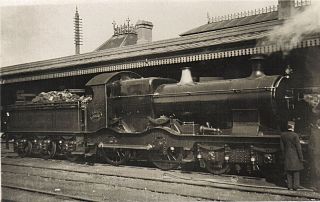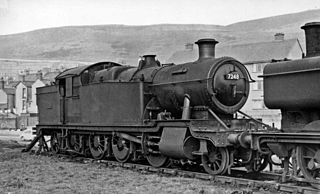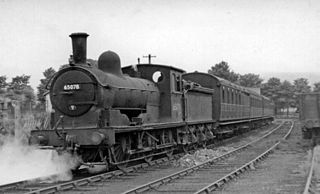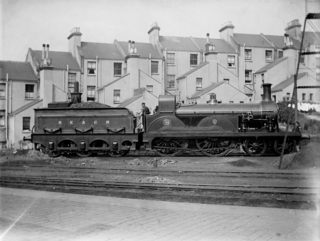| SECR F1 class | |||||||||||||||||||||||||
|---|---|---|---|---|---|---|---|---|---|---|---|---|---|---|---|---|---|---|---|---|---|---|---|---|---|
 | |||||||||||||||||||||||||
| |||||||||||||||||||||||||
| |||||||||||||||||||||||||
| |||||||||||||||||||||||||
| |||||||||||||||||||||||||
The SECR F1 class was a class of 4-4-0 steam locomotives of the South Eastern and Chatham Railway. The class was rebuilt from older Stirling F class locomotives by Harry Wainwright between 1903 and 1919. [1]
| SECR F1 class | |||||||||||||||||||||||||
|---|---|---|---|---|---|---|---|---|---|---|---|---|---|---|---|---|---|---|---|---|---|---|---|---|---|
 | |||||||||||||||||||||||||
| |||||||||||||||||||||||||
| |||||||||||||||||||||||||
| |||||||||||||||||||||||||
| |||||||||||||||||||||||||
The SECR F1 class was a class of 4-4-0 steam locomotives of the South Eastern and Chatham Railway. The class was rebuilt from older Stirling F class locomotives by Harry Wainwright between 1903 and 1919. [1]
Seventy-six locomotives were rebuilt and 75 survived into Southern Railway (SR) ownership on 1 January 1923 with random numbers between 2 and 250. Nine locomotives survived into British Railways (BR) ownership in 1948. [2] Numbers of these nine were:
| SECR no. | SR no. | BR no. |
|---|---|---|
| 2 | 1002 | 31002 |
| 28 | 1028 | 31028 |
| 31 | 1031 | 31031 |
| 42 | 1042 | 31042 |
| 78 | 1078 | 31078 |
| 105 | 1105 | 31105 |
| 151 | 1151 | 31151 |
| 215 | 1215 | 31215 |
| 231 | 1231 | 31231 |

The 4073 or Castle Class are 4-6-0 steam locomotives of the Great Western Railway, built between 1923 and 1950. They were designed by the railway's Chief Mechanical Engineer, Charles Collett, for working the company's express passenger trains. They could reach speeds of up to 100 mph (160 km/h).
The Southern Railway took a key role in expanding the 660 V DC third rail electrified network begun by the London & South Western Railway. As a result of this, and its smaller operating area, its steam locomotive stock was the smallest of the 'Big Four' companies.

The Bulldog and Bird classes were double-framed inside cylinder 4-4-0 steam locomotives used for passenger services on the Great Western Railway. The Bird Class were a development of the Bulldogs with strengthened outside frames, of which a total of fifteen were built. A total of 121 Bulldogs were built new, with a further twenty rebuilt from Duke Class locomotives. Thirty Bulldogs were later rebuilt as Earl Class locomotives and renumbered 3265, 3200-3228.
The SR N15X class or Remembrance class were a design of British 4-6-0 steam locomotives converted in 1934 by Richard Maunsell of the Southern Railway from the large LB&SCR L class 4-6-4 tank locomotives that had become redundant on the London–Brighton line following electrification. It was hoped that further service could be obtained from these locomotives on the Southern's Western Section, sharing the duties of the N15 class locomotives. The locomotives were named after famous Victorian engineers except for Remembrance, which was the LBSCR's memorial locomotive for staff members who died in the First World War.

The London, Midland and Scottish Railway (LMS) Stanier Class 8F is a class of steam locomotives designed for hauling heavy freight. 852 were built between 1935 and 1946, as a freight version of William Stanier's successful Black Five, and the class saw extensive service overseas during and after the Second World War.

The SR West Country and Battle of Britain classes, collectively known as Light Pacifics or informally as Spam Cans, or "flat tops", are air-smoothed 4-6-2 Pacific steam locomotives designed for the Southern Railway by its Chief Mechanical Engineer Oliver Bulleid. Incorporating a number of new developments in British steam locomotive technology, they were amongst the first British designs to use welding in the construction process, and to use steel fireboxes, which meant that components could be more easily constructed under wartime austerity and post-war economy.

The Great Western Railway (GWR) 7200 Class is a class of 2-8-2T steam locomotive. They were the only 2-8-2Ts built and used by a British railway, and the largest tank engines to run on the Great Western Railway.

The Great Western Railway (GWR) 4300 Class is a class of 2-6-0 (mogul) steam locomotives, designed by G.J. Churchward for mixed traffic duties. 342 were built from 1911–1932.

The GWR 5600 Class is a class of 0-6-2T steam locomotive built between 1924 and 1928. They were designed by Charles Collett for the Great Western Railway (GWR), and were introduced into traffic in 1924. After the 1923 grouping, Swindon inherited a large and variable collection of locomotives from historic Welsh railway companies, which did not fit into their standardisation programme. GWR boiler inspectors arrived en masse and either condemned the original locomotives or had them rebuilt. The systematic destruction of many examples of locomotives, most still in serviceable condition, followed, but various were worked alongside 5600 Class.

The North Eastern Railway (NER) Class C1, was a class of 0-6-0 freight locomotives designed by T.W. Worsdell. They were used throughout the NER system, although particularly in Teesside between 1886 and 1962.
The GER Class T26 was a class of 2-4-0 steam tender locomotives designed by James Holden for the Great Eastern Railway. At the 1923 grouping they passed to the London and North Eastern Railway, who classified them E4. Eighteen survived into British Railways ownership in 1948, and the last was withdrawn in 1959, making them the last 2-4-0 tender locomotives at work in Britain. Their BR numbers were 62780–62797.

The LB&SCR D1 class were powerful 0-4-2 suburban passenger tank locomotives, designed by William Stroudley of the London Brighton and South Coast Railway in 1873. They were originally known as "D-tanks" but later reclassified as class D1. Members of this very successful class survived in service until 1951.

The London and North Eastern Railway (LNER) Class V1 and Class V3 were two classes of related 2-6-2T steam locomotive designed by Sir Nigel Gresley. A total of 82 V1s were built with 71 being rebuilt into the higher pressure V3s with an additional ten being built as V3s from the final batch of V1s. The V3 was a development of the V1 with increased boiler pressure and a resultant increase in tractive effort.

The LB&SCR I1 class was a class of 4-4-2 steam tank locomotives designed by D. E. Marsh for suburban passenger service on the London, Brighton and South Coast Railway.

The SECR B1 class was a class of 4-4-0 steam tender locomotive for express passenger service on the South Eastern and Chatham Railway. These engines were originally designed by James Stirling for the South Eastern Railway (SER) in 1898 and designated B class. The SER was merged into the SECR in 1899 and, between 1910 and 1927 the B class engines were rebuilt with new boilers by Harry Wainwright to become B1 class.

The London, Midland and Scottish Railway (LMS) Rebuilt Royal Scot Class is a class of 4-6-0 steam locomotives. 70 members of this class were rebuilt by the LMS and its successor British Railways (BR) from LMS Royal Scot Class engines by the replacement of their life expired parallel boilers with a type 2A boiler over the period 1943–1955.. They were the second class to be rebuilt with type-2 boilers, after the rebuilding of British Legion and the Jubilee Class.

The NER Class P1 was a class of 0-6-0 steam locomotives of the North Eastern Railway. Class P1 was a development of Class P, having a boiler four inches longer, and a firebox six inches longer. To accommodate these, the wheelbase was increased by nine inches. The cylinder stroke was also increased by two inches. None survived into preservation
The SECR Q1 class was a class of 0-4-4T steam locomotives of the South Eastern and Chatham Railway. The class was rebuilt from older Stirling Q class locomotives by Harry Wainwright between 1903 and 1917 by fitting the boiler that had been designed for the H class 0-4-4T in 1902–03.

The SER Q class was a class of 0-4-4T steam locomotives of the South Eastern Railway. The class was designed by James Stirling and introduced in 1881.

The SER F class was a class of 4-4-0 steam locomotives of the South Eastern Railway. The class was designed by James Stirling and introduced in 1883.